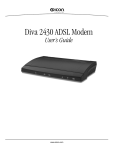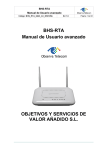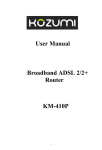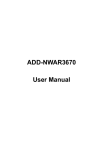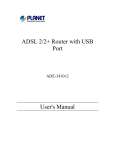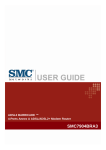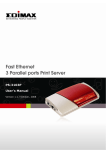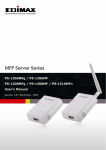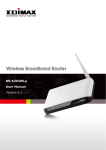Download Edimax AR-7284WnB
Transcript
English Copyright© by Edimax Technology Co, LTD. all rights reserved. No part of this publication may be reproduced, transmitted, transcribed, stored in a retrieval system, or translated into any language or computer language, in any form or by any means, electronic, mechanical, magnetic, optical, chemical, manual or otherwise, without the prior written permission of this Company . This company makes no representations or warranties, either expressed or implied, with respect to the contents hereof and specifically disclaims any warranties, merchantability or fitness for any particular purpose. Any software described in this manual is sold or licensed "as is". Should the programs prove defective following their purchase, the buyer (and not this company, its distributor, or its dealer) assumes the entire cost of all necessary servicing, repair, and any incidental or consequential damages resulting from any defect in the software. Further, this company reserves the right to revise this publication and to make changes from time to time in the contents hereof without obligation to notify any person of such revision or changes. The product you have purchased and the setup screen may appear slightly different from those shown in this QIG. For more detailed information about this product, please refer to the User Manual on the CD-ROM. The software and specifications are subject to change without notice. Please visit our web site www.edimax.com for the update. All rights reserved including all brand and product names mentioned in this manual are trademarks and/or registered trademarks of their respective holders . ii Notice according to GNU/GPL-Version 2 This product includes software that is subject to the GNU/GPL-Version 2. You find the text of the license on the product cd/dvd. The program is free software and distributed without any warranty of the author. We offer, valid for at least three years, to give you, for a charge no more than the costs of physically performing source distribution, a complete machine-readable copy of the corresponding source code. Please contact Edimax at: Edimax Technology co., Ltd, NO. 3, Wu-Chuan 3rd RD Wu-Ku-Industrial Park, Taipei Hsien, Taiwan. R.O.C., TEL : +886-2-77396888, +886-2-77396887, [email protected] iii FAX : Contents 1 2 3 Introduction ......................................................................................... 1 1.1 Package List....................................................................... 2 1.2 Safety Cautions .................................................................. 3 1.3 LEDs and Interfaces ........................................................... 4 1.4 System Requirements ........................................................ 6 1.5 Features ............................................................................. 7 Hardware Installation .......................................................................... 8 2.1 Connecting the ADSL Router ............................................. 8 2.2 USB Installation ................................................................ 10 About the Web Configurator ............................................................. 12 3.1 Access the Device ............................................................ 12 3.2 Setup ................................................................................ 13 3.2.1 Wizard...................................................................... 13 3.2.2 Internet Setup .......................................................... 23 3.2.3 Wireless Setup ......................................................... 25 3.2.4 Local Network .......................................................... 28 3.2.5 Time and Date ......................................................... 30 3.2.6 Logout ...................................................................... 31 3.3 Advanced ......................................................................... 31 3.3.1 Advanced Wireless .................................................. 31 3.3.2 Port Forwarding ....................................................... 40 3.3.3 DMZ ......................................................................... 42 3.3.4 Parental Control ....................................................... 42 i 3.3.5 Filtering Options ....................................................... 47 3.3.6 QoS Configuration ................................................... 52 3.3.7 Firewall Settings ...................................................... 56 3.3.8 DNS ......................................................................... 57 3.3.9 Dynamic DNS .......................................................... 59 3.3.10 Network Tools .......................................................... 60 3.3.11 Routing .................................................................... 72 3.3.12 Schedules ................................................................ 76 3.4 Management .................................................................... 77 3.4.1 System ..................................................................... 77 3.4.2 Firmware Update ..................................................... 78 3.4.3 Access Controls ....................................................... 79 3.4.4 Diagnostics .............................................................. 83 3.4.5 Log Configuration .................................................... 83 3.5 Status ............................................................................... 84 3.5.1 Device Info ............................................................... 84 3.5.2 Wireless Clients ....................................................... 86 3.5.3 DHCP Clients ........................................................... 86 3.5.4 Logs ......................................................................... 87 3.5.5 Statistics................................................................... 88 3.5.6 Route Info ................................................................ 89 ii 1 Introduction The AR-7284WnA supports AnnexA mode. It provides four 10/100 base-T Ethernet ports for user. The device provides high-speed ADSL2+ broadband connection to the Internet or Intranet for high-end users, such as net bars and office users. It provides high performance access to the Internet, downstream up to 24 Mbps and upstream up to 1 Mbps. The device supports WLAN access to the Internet, such as WLAN AP or WLAN device. It complies with IEEE 802.11b/g, IEEE 802.11n specifications, WEP, WPA, and WPA2 security specifications. You can configure the router by running the Setup Wizard in the CD-ROM provided in the package. The wizard provides quick setup for Internet connection, Ethernet WAN Internet connection, SSID, wireless security, firmware upgrade and changing router’s password. When you start the Setup Wizard, you will get the following Welcome screen. Please choose the language to start with and follow the easy steps in the Wizard. No instruction for the Setup Wizard is given here. If you lost the CD-ROM or you prefer the traditional web setup, please follow the procedures in Manual to configure the router 1 1.1 Package List 1 x AR-7284WnA or AR-7284WnB 1 x external splitter 1 x power adapter 2 x telephone cables (RJ-11) 1 x Ethernet cable (RJ-45) 1 x Quick Installation Guide(QIG) 1 x CD (Multi-languages EZmax Wiard / QIG , USB driver & English Manual) 2 1.2 Safety Cautions Follow the following instructions to prevent the device from risks and damage caused by fire or electric power: Use volume labels to mark the type of power. Only use the power adapter packed within the device package. Pay attention to the power load of the electric outlet or power extension cord. An overloaded power outlet or damaged lines and plugs may cause electric shock or fire accident. Check the power cords regularly. If you find any damage, replace it as soon as possible. It’s necessary to prepare proper space for heat dissipation to avoid damage caused by overheating. The long and thin holes on the device are designed for heat dissipation and to ensure that the device works normally. Do not cover these heat dissipation holes. Do not put this device in high temperature environment and avoid direct sunlight. Do not put this device in humid or watery environment. Do not spill any fluid on this device. Do not connect this device to any PCs or electronic products, unless our customer engineer or your broadband provider instructs you to do so, because any wrong connection may lead to electric or fire risk. Do not place this device on an unstable surface. 3 1.3 LEDs and Interfaces Front Panel Figure 1 Front panel The following table describes the LEDs of the device. LED Color Status Description Off Green Red LAN 1/2/3/4 Green On On Blinks Off Blinks On Off Green Blinks On Green ADSL Green Off Blinks On Off Blinks On Internet Green Off The power is off. The power is on and the initialization is normal. The device is initiating. The firmware is upgrading. No LAN link. Data is being transmitted through the LAN interface. The connection of LAN interface is normal. No WLAN connection. Data is transmitted through the WLAN interface. The connection of WLAN interface is normal. No USB signal is detected. Data is passing through USB port. The USB interface is ready. Initial self-test is failed. The device is detecting DSL signal. The DSL line connection is established. The device is running under Bridge 4 LED Color Red Status On On On WPS Green Blink Green Off Description mode, DSL connection is not present, or the power is off. Connected to network. Network connection failed. The WPS indicator will light for 5 minutes after the WPS service is registered successfully. The WPS indicator will light for 0.2s, and then off for 0.1s when the WPS button is pressed and the network card is ready for register. The WPS indicator will blink every 0.1s to indicate the WPS service fails to register. The WPS indicator lights for 5 times and off for 0.5s to indicate there are two or more wireless network cards register at the same time. WPS service is not ready or WPS service has been setup successfully. 5 Rear Panel Figure 2 Rear panel The following table describes the interface of the device. Interface/Button Description Line WPS/Reset LAN1/2/3/4 Power ON/OFF RJ-11 interface that connects to the telephone set through the telephone cable. Press the button for 3 seconds to enable WPS. Press the button for 8 seconds to restore factory default configurations and reboot the device. Ethernet RJ-45 interface is connected to the Ethernet interfaces of computers or Ethernet devices. USB device interface is connected to PC or other network devices. Power Jack that connects to power adapter. The power adapter output is: 12 V DC, 800 mA. Power switch. 1.4 System Requirements Recommended system requirements are listed as follows: An 10 baseT/100BaseT Ethernet interface on your PC A hub or switch (connected to multiple PCs through one of Ethernet interfaces on this device) Operating system: Windows 98SE, Windows 2000, Windows ME, or Windows XP 6 Internet Explorer V5.0 or higher, Netscape V4.0 or higher, or Firefox 1.5 or higher 1.5 Features The device supports the following features: Various line modes External PPPoE dial-up access Internal PPPoE and PPPoA dial-up access Leased line mode Zero installation PPP bridge mode (ZIPB) 1483B, 1483R, and MER access Multiple PVCs (up to eight), PVCs are independent Single PVC with multiple sessions Multiple PVCs with multiple sessions Binding PVC ports 802.1Q and 802.1P protocol DHCP server NAT and NAPT Static route Firmware upgrade via Web, TFTP and FTP Reset to the factory default setting DNS relay Virtual server DMZ Web user interface System status display PPP session PAP and CHAP IP filter IP QoS Remote access control Remote management Backup and restoration of configuration file Ethernet interface supports crossover detection, auto-correction and polarity correction UPnP 7 2 Hardware Installation 2.1 Connecting the ADSL Router Step 1 Connect the ‘Line’ port of the device and the ‘Modem’ port of the ADSL splitter with a telephone cable. Connect the phone to the ‘Phone’ port of the splitter through a telephone cable. Connect the incoming line to the ‘Line’ port of the splitter. The splitter has three ports: Line: Connect to the phone port on the wall (RJ-11 jack). Modem: Connect to the DSL port of the device. Phone: Connectto a telephone set. Step 2 Connect the LAN port of the device to the network card of the PC through an Ethernet cable (MDI/MDIX). Note: Use twisted-pair cables to connect with the Hub or switch. Step 3 Plug one end of the power adapter to the wall outlet and connect the other end to the Power port of the device. Connection type 1: Figure 3 shows the application diagram for the connection of the device, PC, splitter and telephone sets, when no telephone set is placed before the splitter. 8 Figure 3 Connection diagram (without telephone sets before the splitter) Connection type 2: Figure 4 displays the application diagram for the connection of the device, PC, splitter and telephone sets when a telephone set is placed before the splitter. As illustrated in the following figure, the splitter is installed close to the device. Figure 4 Connection diagram (with a telephone set before the splitter) Connection 1 is recommended. Note: When connection type 2 is used, the filter must be installed close to the telephone cable. See Figure 4. Do not use the splitter to replace the filter. 9 Installing a telephone before the splitter may cause connection problem between the device and the central office, or failure of Internet access, or slow connection speed. If you really need to add a telephone set before the splitter, you must add a microfilter before a telephone set. Do not connect several telephones before the splitter or connect several telephones with one microfilter. 2.2 USB Installation To connect the DSL gateway to the USB port of the PC, follow the instructions listed as follow: Step 1 Connect one end of the USB cable to the USB port of the DSL gateway. As the cable has two different connectors and each connector is keyed, you may need to try both connectors and different orientations. Step 2 Connect the other end of the USB cable into the USB port of the PC. Step 3 For USB installation on Windows XP, once the PC powers up, a message appears in the system tray indicating that new hardware is found. Step 4 The Found New Hardware Wizard dialog box appears. Select Install the software automatically (Recommended) and insert the Manual and Driver CD-ROM. Click Next. The system searches CD-ROM for the best USB driver. 10 Step 5 The dialog will instruct you to choose driver from specific location. 11 3 About the Web Configurator This chapter describes how to configure the device by the Web-based configuration utility. 3.1 Access the Device Follow the following instructions to access the device for the first time. Step 1 Open the Internet Explorer (IE) browser and enter http://192.168.2.1. Step 2 The Login page shown in the following figure appears. Enter the user name and password. The user name and password of the super user are admin and 1234. The user name and password of the normal user are user and user. 12 If you successfully logged in as the super user, the web page as shown in the following figure appears. 3.2 Setup 3.2.1 Wizard Wizard enables fast and accurate configuration of Internet connection and other important parameters. The following sections describe these configuration parameters. When subscribing to a broadband service, you should be aware of the connection method. Your physical WAN device can be Ethernet, DSL, or both of them. Technical information about the properties of your Internet connection is provided by your Internet service provider (ISP). For example, your ISP should inform you whether you are connected to the Internet using a static or dynamic IP address, or the protocol, such as PPPoA or PPPoE, that you use to communicate over the Internet. 13 Step 1 Choose Setup > Wizard. The page shown in the following figure appears. Step 2 Click Setup Wizard. The page shown in the following figure appears. Step 3 There are four steps to configure the device. Click Next to continue. 14 Step 4 Set the time and date. 15 Step 5 Configure the Internet connection. Select the country and ISP. Set the VPI and VCI. If you failed to find the country and ISP from the drop-down lists, select Others. Click Next. If the Protocol you selected is PPPoE or PPPoA, the page shown in either of the two following figures appears. 16 Set the user name and password here,which is provided by your ISP. If the Protocol is Dynamic IP, the page shown in the following figure appears. Click Next, the page shown in the following figure appears. 17 Configure the wireless network. Enter the information and click Next. 18 If the Protocol is Bridge, the page shown in the following figure appears. 19 If the Protocol is Static IP, the page shown in the following figure appears. 20 Enter the IP Address, Subnet Mask, Default Gateway, and Primary DNS Server. Click Next. The page shown in the following page appears. Figure 5 21 Step 6 Configure the wireless network. Enter the information and click Next. Step 7 When the settings are complete, click Apply to apply the settings. Note: In each step of the Wizard page, you can click Back to review or modify settings in previous page. Click Cancel to exit the wizard page. 22 3.2.2 Internet Setup Choose Setup > Internet Setup. The page shown in the following figure appears. In this page, you can configure the WAN interface of the device. Click Add. The page shown in the following figure appears. 23 Click Apply. The page shown in the following figure appears. 24 3.2.3 Wireless Setup This section describes the wireless LAN and some basic configuration. Wireless LANs can be as simple as two computers with wireless LAN cards communicating in a pear-to-pear network or as complex as a number of computers with wireless LAN cards communicating through access point which bridges network traffic to wired LAN. Choose Setup > Wireless Setup. The Wireless Setup page shown in the following figure appears. 25 3.2.3.1 Wireless Basics In the Wireless Setup page, click Wireless Basics. The page shown in the following figure appears. In this page, you can configure the parameters that wireless LAN clients can used to connect to this device. Click Apply to save the settings. 26 3.2.3.2 Wireless Security In the Wireless Setup page, click Wireless Security. The page shown in the following figure appears. Wireless security is vital to your network to protect the wireless communication among wireless stations, access points and wired network. Click Apply to save the settings. 27 3.2.4 Local Network You can configure the LAN IP address according to actual requirements. The preset IP address is 192.168.1.1. You can use the default settings and DHCP service to manage the IP settings for the private network. The IP address of the device is the base address used for DHCP. To use the device as DHCP server on your LAN, the DHCP IP address pool must be compatible with the IP address of the device. The IP address available in the DHCP IP address pool changes automatically if you change the IP address of the device. You can also enable the secondary LAN IP address. The two LAN IP addresses must be in different networks. Choose Setup > Local Network. The Local Network page shown in the following figure appears. By default, Enable DHCP Server is selected for the Ethernet LAN interface of the device. DHCP service will assign IP address to client computer connected to LAN interface. When the device acts as DHCP server, it will become the gateway of all computers on intranet. If you change the IP address of the device, you must also change the range of IP addresses in 28 the pool used for DHCP. The IP address pool can contain up to 253 IP addresses. Click Apply to save the settings. In the Local Network page, you can assign IP addresses on the LAN to specific individual computers based on their MAC addresses. Click Add to add static DHCP addresses (optional). The page shown in the following figure appears. Select Enable to reserve the IP address for the designated PC with the specified MAC address. The Computer Name helps you to recognize the PC with the MAC address. For example: Father’s Laptop. Click Apply to save the settings. After the DHCP reservation is saved, the DHCP reservations list displays the configuration. If the DHCP reservations list table is not empty, you can select one or more items and click Edit or Delete. 29 The NUMBER OF DYNAMIC DHCP CLIENTS page shows the current DHCP clients (PC or Laptop) connected to the device and the detailed information of the connected computer(s). 3.2.5 Time and Date Choose Setup > Time and Date. The page shown in the following figure appears. In the Time and Date page, you can setup the time of the internal system clock. You can also set the time zone of the area of residence and the network time protocol (NTP) server. You can also configure daylight saving setting by selecting Automatically synchronize with Internet time servers. 30 Select the specific time server and the time zone from the corresponding item in drop-down lists. Select Enable Daylight Saving if necessary. Click Apply to save the settings. 3.2.6 Logout Choose Setup > Logout. The page shown in the following figure appears. In this page, you can log out from web configuration menu. 3.3 Advanced This section includes advanced features used for network management, security and administrative tools to manage the device. You can view status and other information that are used to evaluate system performance and troubleshooting. 3.3.1 Advanced Wireless Settings This function is used to modify the standard 802.11 wireless settings. It is recommend not to change the default settings, because incorrect settings may impair the performance of 31 your wireless performance. The default settings provide the best wireless radio performance in most of environments. 32 3.3.1.1 Advanced Settings Select Advance Settings. The page shown in the following figure appears. These settings are only for technically advanced users who have sufficient knowledge about wireless LAN. Do not change these settings unless you know the effect of changes on the device. 33 Click Apply to save the settings. 3.3.1.2 MAC Filtering Select MAC Filtering. The page shown in the following figure appears. 34 Click Add. The page shown in the following figure appears. Click Apply to save the settings. 35 3.3.1.3 Security Settings Select Security Settings. The page shown in the following figure appears. Select the SSID that you want to configure from the drop-down list. Select the encryption type from the Security Mode drop-down list.You can select None, WEP, AUTO (WPA or WPA2), WPA Only, or WPA2 Only. If you select WEP, the page shown in the following figure appears. 36 If you select AUTO (WPA or WPA2), WPA Only, or WPA2 Only, the page shown in the following figure appears. 37 Click Apply to save the settings. 38 3.3.1.4 WPS Settings Select WPS Settings. The page shown in the following figure appears. WPS Authentication: The WPS service is enabled by default. There are three setting methods you can use in the Wi-Fi Protected Setup. In order to use wps authentication, you can select one method from three methods. Press the WPS button on the rear panel for 3 seconds. In the WPS Settings page, click PBC. After setting, click Apply to make the setting effective. In the WPS Settings page, enter the PIN codes provided by station (STA), then click PIN. After settings, click Apply to take the settings effective. 39 3.3.2 Port Forwarding This function is used to open ports on your device and redirect data from those ports to a single PC on your network (WAN-to-LAN traffic). It allows remote users to access services on your LAN, such as FTP for file transfers or SMTP and POP3 for e-mail. The device accepts remote requests for these services at your global IP address. It uses the specified TCP or UDP protocol and port number, and redirects these requests to the server on your LAN with the LAN IP address you specificed. Note that the specified private IP address must be within the available range of the subnet where the device is in. Choose ADVANCED > Port Forwarding. The page shown in the following figure appears. Click Add to add a virtual server. 40 Select a service for a preset application, or enter a name in the Custom Server field. Enter an IP address in the Server IP Address field, to appoint the corresponding PC to receive forwarded packets. The Ports show the ports that you want to open on the device. The TCP/UDP means the protocol type of the opened ports. Click Apply to save the settings. 41 3.3.3 DMZ Since some applications are not compatible with NAT, the device supports the use of a DMZ IP address for a single host on the LAN. This IP address is not protected by NAT and it is visible to agents on the Internet with the correct type of software. Note that any client PC in the DMZ is exposed to various types of security risks. If you use the DMZ, take measures (such as client-based virus protection) to protect the remaining client PCs on your LAN from possible contamination through DMZ. Choose ADVANCED > DMZ. The page shown in the following figure appears. Click Apply to save the settings. 3.3.4 Parental Control Choose ADVANCED > Parental Control. The Parental Control page shown in the following figure appears. 42 This page provides two useful tools for restricting the Internet access. Block Websites allows you to quickly create a list of all websites that you wish to stop users from accessing. Block MAC Address allows you to control when clients or PCs connected to the device are allowed to access the Internet. 43 3.3.4.1 Block Website In the Parental Control page, click Block Website. The page shown in the following figure appears. Click Add. The page shown in the following page appears. Enter the website in the URL field. Select the Schedule from drop-down list, or select Manual Schedule and select the corresponding time and days. 44 Click Submit to add the website to the BLOCK WEBSITE Table. The page shown in the following figure appears. 3.3.4.2 Block MAC Address In the Parental Control page, click Block MAC Address. The page shown in the following figure appears. b Click Add. The page shown in the following figure appears. 45 Enter the user name and MAC address and select the corresponding time and days. Click Submit to add the MAC address to the BLOCK MAC ADDRESS Table. 46 3.3.5 Filtering Options Choose ADVANCED > Filtering Options. The Filtering Options page shown in the following figure appears. 3.3.5.1 Inbound IP Filtering By default, all incoming IP traffic that does not originate from the internal network is blocked when the firewall is enabled. Normal outbound requests created by web browsing, email and other software you run, work as usual as the requests originated from your internal network. The inbound filter allows you to create a filter rule to allow incoming IP traffic by specifying a filter name and you need to select at least one condition. In the Filtering Options page, click Inbound IP Filtering. The page shown in the following figure appears. 47 Click Add to add an inbound IP filter. The page shown in the following figure appears. 48 Enter the Filter Name and specify at least one of the following criteria: protocol, source/destination IP address, subnet mask, and source/destination port. Click Apply to save the settings. Note: The settings only apply when the firewall is enabled. The ACTIVE INBOUND FILTER shows detailed information about every created inbound IP filter. Click Delete to remove an IP filter (only appears when an IP filter exists). 3.3.5.2 Outbound IP Filtering By default, all outgoing IP traffic from the LAN is allowed. The outbound filter allows you to create a filter rule to block outgoing IP traffic by specifying a filter name and at least one condition. 49 In the Filtering Options page, click Outbound IP Filtering. The page shown in the following figure appears. Click Add to add an outbound IP filter. The page shown in the following figure appears. 50 Enter the Filter Name and specify at least one of the following criteria: protocol, source/destination IP address, subnet mask, and source/destination port. Click Apply to save the settings. 3.3.5.3 Bridge Filtering In the Filtering Options page, click Bridge Filtering. The page shown in the following figure appears.This page is used to configure bridge parameters. In this page, you can change the settings or view some information of the bridge and attached ports. Click Add to add a bridge filter. The page shown in the following figure appears. 51 Click Apply to save the settings. 3.3.6 QoS Configuration Choose ADVANCED > QOS Config. The QoS Configuration page shown in the following figure appears. 52 3.3.6.1 QoS Interface In the QoS Configuration page, click QoS Interface Config. The page shown in the following figure appears. In this page, you can configure bandwidth control. Click Edit, the page shown in the following figure appears. After configuration, click Apply to make configurations take effect. 53 3.3.6.2 QoS Queue Configuration In the QoS Configuration page, click QoS Queue Config. The page shown in the following figure appears. In this page, you can configure the priority of queue. Click Add, the page shown in the following figure appears. After configuration, click Apply to take the configurations effect. 3.3.6.3 QoS Classify Configuration In the QoS Configuration page, click QoS Classify Configuration. The page shown in the following figure appears. In this page, you can assign a QoS classification. 54 Click Add, the page shown in the following figure appears. 55 After configuration is done, click Apply to make the configuration take effect. 3.3.7 Firewall Settings A denial-of-service (DoS) attack is characterized by an explicit attempt by attackers to prevent legitimate users from using that service. Examples include the following The attackers attempt to flood a network, thereby preventing legitimate network traffic The attackers attempt to disrupt connections between two machines, thereby preventing access to a service The attackers attempt to prevent a particular individual 56 from accessing a service The attackers attempt to disrupt service to a specific system or person. Port scan protection is designed to block attempts to discover vulnerable ports or services that might be exploited in an attack from the WAN. Choose ADVANCED > Firewall Settings. The page shown in the following figure appears. Click Apply to save the settings. 3.3.8 DNS Domain name system (DNS) is an Internet service that translates domain names into IP addresses. Because domain names are alphabetic, they are easier to remember. The Internet, however, is actually based on IP addresses. Each time you use a domain name, a DNS service must translate 57 the name into the corresponding IP address. For example, the domain name www.example.com might be translated to 198.105.232.4. The DNS system is, in fact, its own network. If one DNS server does not know how to translate a particular domain name, it asks another one, and so on, until the correct IP address is returned. Choose ADVANCED > DNS. The page shown in the folllowing figure appears. DNS SERVER CONFIGURATION If you are using the device as DHCP server on the LAN, or if you are using DNS servers provided by your ISP, select Obtain DNS server address automatically. If you have DNS IP addresses provided by your ISP, enter these IP addresses in the preferred DNS server and the alternate DNS server field. Click Apply to save the settings. 58 3.3.9 Dynamic DNS The device supports dynamic domain name service (DDNS). The dynamic DNS service allows a dynamic public IP address to be associated with a static host name in any of the many domains, and allows access to a specified host from various locations on the Internet. Click a hyperlinked URL in the form of hostname.dyndns.org and allow remote access to a host. Many ISPs assign public IP addresses using DHCP, so locating a specific host on the LAN using the standard DNS is difficult. For example, if you are running a public web server or VPN server on your LAN, DDNS ensures that the host can be located from the Internet even the public IP address changes. DDNS requires that an account be set up with one of the supported DDNS service providers (DyndDNS.org or dlinkddns.com). Choose ADVANCED > Dynamic DNS. The page shown in the following page appears. Click Add to add dynamic DNS. The page shown in the following figure appears. 59 DDNS provider: Select one of the DDNS service provider from the down-list. Available service providers include DynDns.org and dlinkddns.com. Host Name: Enter the host name that you registered with your DDNS service provider. Username: Enter the user name for your DDNS account. Password: Enter the password for your DDNS account. Click Apply to save the settings. 3.3.10 Network Tools Choose ADVANCED > Network Tools. The page shown in the following figure appears. 60 61 3.3.10.1 Port Mapping Choose ADVANCED > Network Tools and click Port Mapping. The page shown in the following figure appears. In this page, you can bind the WAN interface and the LAN interface to the same group. Click Add to add a new port mapping. The page shown in the following figure appears. 62 The procedure for creating a mapping group is listed as follows: Step 1 Enter the group name. Step 2 Select interfaces from the Available Interface list and click the <- arrow button to add them to the grouped interface list, in order to create the required mapping of the ports. The group name must be unique. Step 3 Click Submit to save the settings. 63 3.3.10.2 IGMP Proxy Choose ADVANCED > Network Tools and click IGMP Proxy. The page shown in the following figure appears. IGMP proxy enables the system to issue IGMP host messages on behalf of hosts that the system discovered through standard IGMP interfaces. The system acts as a proxy for its hosts after you enable it. Click Apply to save the settings. 3.3.10.3 IGMP Snooping Choose ADVANCED > Network Tools and click IGMP Snooping. The page shown in the following figure appears. 64 After configuration, click Apply to save the settings. 3.3.10.4 UPnP Choose ADVANCED > Network Tools and click UPnP. The page shown in the following figure appears. 65 In this page, you can configure universal plug and play (UPnP). The system acts as a daemon after you enable UPnP. UPnP is used for popular audio / video software. It allows automatic discovery of your device in the network. If you are concerned about UPnP security, you can disable it. Block ICMP ping should be enabled so that the device will not respond malicious Internet requests. Click Apply to save the settings. 3.3.10.5 ADSL Settings Choose ADVANCED > Network Tools and click ADSL Settings. The page shown in the following figure appears. In this page, you can select the DSL modulation. Normally, you can keep factory default setting. 66 The AR-7284WnA supports AnnexA mode, so the AnnexB is not enabled. Click Apply to save the settings. 67 3.3.10.6 SNMP Choose ADVANCED > Network Tools and click SNMP. The page shown in the following figure appears. In this page, you can set SNMP parameters. Read Community: The network administrator must use this password to read the information of this device. Set Community: The network administrator must use this password to configure the information of this device. Trap Manager IP: The trap information is sent to this host. Click Apply to save the settings. 68 3.3.10.7 TR069 Choose ADVANCED > Network Tools and click TR-069. The page shown in the following figure appears. In this page, you can configure the TR069 CPE. Click Apply to save settings. 69 3.3.10.8 Certificates Choose ADVANCED > Network Tools and click Certificates. The Certificates page shown in the following figure appears. In the Certificates page, click Trusted CA. The page shown in the following figure appears. Click Input Certificate, the page shown in the following figure appears. 70 Click Apply to save the settings. 71 3.3.11 Routing Choose ADVANCED > Routing. The page shown in the following page appears. 3.3.11.1 Static Route Choose ADVANCED > Routing and click Static Route. The page shown in the following figure appears. This page is used to configure the routing information. In this page, you can add or delete IP routes. 72 Click Add to add a static route. The page shown in the following figure appears. Destination Network Address: The destination network address. Subnet Mask: The subnet mask of the destination network. Use Gateway IP Address: The gateway IP address of the destination network. User Interface: The interface name of the router output port. You can only choose Use Gateway IP Address or User Interface. 73 Click Apply to save the settings. 3.3.11.2 Default Gateway Choose ADVANCED > Routing and click Default Gateway. The page shown in the following figure appears. Click Apply to save the settings. 74 3.3.11.3 RIP Settings Choose ADVANCED > Routing and click RIP Settings. The page shown in the following figure appears. This page is used to select the interfaces on your device that use RIP and the version of the protocol being used. If you are using this device as a RIP-enabled device to communicate with others using the routing information protocol, enable RIP and click Apply to save the settings. 75 3.3.12 Schedules Choose ADVANCED > Schedules. The page shown in the following figure appears. Click Add to add schedule rule. The page shown in the following figure appears. Click Submit to save settings. 76 3.4 Management 3.4.1 System Choose Management > System Management. The System page shown in the following figure appears. In this page, you can reboot device, back up the current settings to a file, restore the settings from the file saved previously, and restore the factory default settings. The buttons in this page are described as follows: Reboot: Reboot the device. 77 Backup Setting: Save the settings to the local hard drive. Select a location on your computer to back up the file. You can name the configuration file. Update Setting: Click Browse to select the configuration file of device and click Update Settings to begin restoring the device configuration.. Restore Default Setting: Reset the device to default settings. Notice: Do not turn off your device or press the Reset button while an operation in this page is in progress. 3.4.2 Firmware Update Choose Management > Firmware Update. The page shown in the following figure appears. In this page, you can upgrade the firmware of the device. The procedure for updating the firmware is as follows: Step 1 Click Browse…to search the file. 78 Step 2 Click Update Firmware to copy the file. The device loads the file and reboots automatically. Notice: Do not turn off your device or press the reset button while this procedure is in progress. 3.4.3 Access Controls Choose Management > Access Controls. The Access Controls page shown in the following figure appears. The page contains Account Password, Services, and IP Address. 79 3.4.3.1 Account Password In the Access Controls page, click Account Password. The page shown in the following figure appears. In this page, you can change the password of the user and set time for automatic logout. You should change the default password to secure your network. Ensure that you remember the new password or write it down and keep it in a safe and separate location for future reference. If you forget the password, you need to reset the device to the factory default settings and all configuration settings of the device will be lost. Select the Username from the drop-down list. You can select admin, support, or user. Enter the current password, and input new password in both ‘New Password’ and ‘Confirm Password’ field to change the password. 80 Click Apply to save the settings. 3.4.3.2 Services In the Access Controls page, click Services. The page shown in the following figure appears. In this page, you can enable or disable the services that are opened to remote host. For example, if telnet service is enabled, the remote host can access the device by telnet through port 23. Normally, you don’t need to change the settings. Select the management services that you want to enable or disable on the LAN or WAN interface. Click Apply to apply the settings. Note: If you disable HTTP service, you cannot access the configuration web page of the device any more. 81 3.4.3.3 IP Address In the Access Controls page, click IP Address. The page shown in the following figure appears. In this page, you can configure the IP address used with access control list (ACL). If ACL is enabled, only devices with the specified IP addresses can access the device. Select Enable Access Control Mode to enable ACL. Note: If you enable the ACL capability, ensure that IP address of the host is in ACL list. Click Add. The page shown in the following figure appears. Click Apply to apply the settings. 82 3.4.4 Diagnostics Choose Management > Diagnostic. The page shown in the following figure appears. In this page, you can test the device. Click Run Diagnostics Test to run diagnostics. 3.4.5 Log Configuration Choose Management > Log Configuration. The System Log page shown in the following figure appears. 83 This page displays event log data in the chronological manner. You can read the event log from the local host or send it to a syslog server. Available event severity levels are as follows: Emergency, Alert, Critical, Error, Warning, Notice, Informational and Debugging. In this page, you can enable or disable the system log function. The procedure for logging the events is as follows: Step 1 Select Enable Log. Step 2 Select the display mode from the Mode drop-down list. Step 3 Enter the Server IP Address and Server UDP Port if the Mode is set to Both or Remote. Step 4 Click Apply to apply the settings. Step 5 Click View System Log to view the detail information of system log. 3.5 Status You can view the system information and monitor device performance. 3.5.1 Device Info Choose Status > Device Info. The page shown in the following figure appears. 84 The page displays the summary of the device status. It includes the information of firmware version, upstream rate, downstream rate, uptime and Internet configuration (both wireless and Ethernet statuses). 85 3.5.2 Wireless Clients Choose Status > Wireless Clients. The page shown in the following page appears. The page displays authenticated wireless stations and their statuses. 3.5.3 DHCP Clients Choose Status > DHCP Clients. The page shown in the following page appears. This page displays all client devices that obtain IP address from the device. You can view the host name, IP address, MAC address and expire time. 86 3.5.4 Logs Choose Status > Logs. The page shown in the following figure appears. Click Refresh to refresh the system log shown in the table. 87 3.5.5 Statistics Choose Status > Statistics. The page shown in the following figure appears. This page displays the statistics of the network and data transfer. This information helps technicians to identify if the device is functioning properly. The information does not affect the functionality of the device. 88 3.5.6 Route Info Choose Status > Route Info. The page shown in the following figure appears. The table shows a list of destination routes commonly accessed by the network. 89 Federal Communication Commission Interference Statement This equipment has been tested and found to comply with the limits for a Class B digital device, pursuant to Part 15 of FCC Rules. These limits are designed to provide reasonable protection against harmful interference in a residential installation. This equipment generates, uses, and can radiate radio frequency energy and, if not installed and used in accordance with the instructions, may cause harmful interference to radio communications. However, there is no guarantee that interference will not occur in a particular installation. If this equipment does cause harmful interference to radio or television reception, which can be determined by turning the equipment off and on, the user is encouraged to try to correct the interference by one or more of the following measures: 1. Reorient or relocate the receiving antenna. 2. Increase the separation between the equipment and receiver. 3. Connect the equipment into an outlet on a circuit different from that to which the receiver is connected. 4. Consult the dealer or an experienced radio technician for help. FCC Caution This device and its antenna must not be co-located or operating in conjunction with any other antenna or transmitter. This device complies with Part 15 of the FCC Rules. Operation is subject to the following two conditions: (1) this device may not cause harmful interference, and (2) this device must accept any interference received, including interference that may cause undesired operation. Any changes or modifications not expressly approved by the party responsible for compliance could void the authority to operate equipment. 90 Federal Communications Commission (FCC) Radiation Exposure Statement This equipment must be installed and operated in accordance with provided instructions and a minimum 20 cm spacing must be provided between computer mounted antenna and person’s body (excluding extremities of hands, wrist and feet) during wireless modes of operation. The equipment version marketed in US is restricted to usage of the channels 1-11 only. R&TTE Compliance Statement This equipment complies with all the requirements of DIRECTIVE 1999/5/EC OF THE EUROPEAN PARLIAMENT AND THE COUNCIL of March 9, 1999 on radio equipment and telecommunication terminal Equipment and the mutual recognition of their conformity (R&TTE) The R&TTE Directive repeals and replaces in the directive 98/13/EEC (Telecommunications Terminal Equipment and Satellite Earth Station Equipment) As of April 8, 2000. Safety This equipment is designed with the utmost care for the safety of those who install and use it. However, special attention must be paid to the dangers of electric shock and static electricity when working with electrical equipment. All guidelines of this and of the computer manufacture must therefore be allowed at all times to ensure the safe use of the equipment. EU Countries Intended for Use The ETSI version of this device is intended for home and office use in Austria, Belgium, Denmark, Finland, France, Germany, Greece, Ireland, Italy, Luxembourg, Bulgaria, Cyprus, Czech Republic, Estonia, Hungary, Latvia, Lithuania, Malta, Poland, Romania, Slovakia, Slovenia, the Netherlands, Portugal, Spain, Sweden, and the United Kingdom. The ETSI version of this device is also authorized for use in 91 EFTA member states: Iceland, Liechtenstein, Norway, and Switzerland. EU Countries not intended for use None A declaration of conformity is available on www.edimax.com N20379 92

































































































